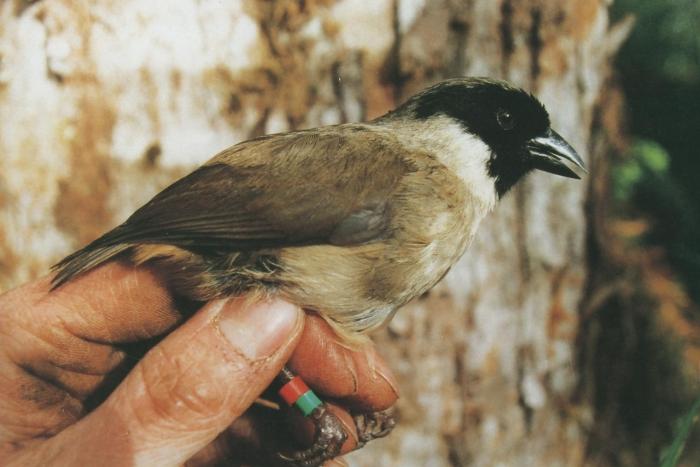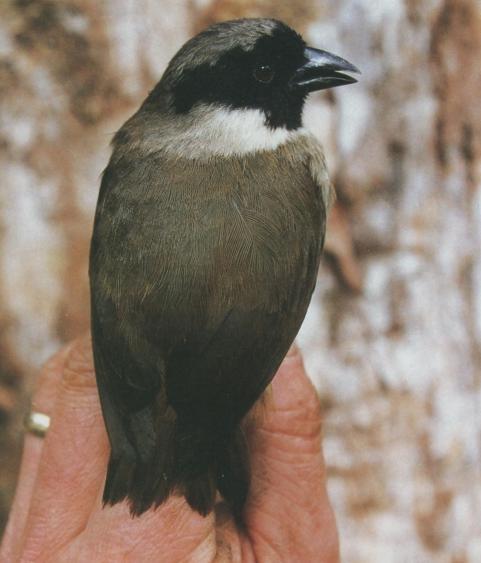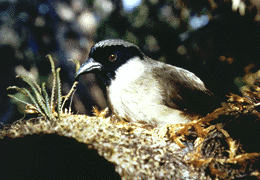Melamprosops phaeosoma Casey & Jacobi, 1974:219
Po'ouli, Po'o-uli, Poouli, Po'o uli, Poo-uli, Black-faced honeycreeper
Taxonomy & Nomenclature
Conservation Status
Extinct
Last record: 28 November 2004 (Kittelberger et al., 2024 [as 2004])
IUCN RedList status: Extinct
Distribution
Maui, Hawaiian Islands
Biology & Ecology
Hypodigm
Media

Above: Paul E. Baker/USFWS (U.S. Fish and Wildlife Service). Source: Wikimedia Commons.

Above: Paul E. Baker/USFWS (U.S. Fish and Wildlife Service). Source: Wikimedia Commons.

Above: photo by Paul Baker (USFWS). Source: Wikimedia Commons.
Two little reproduced photographs of a ringed Po'ouli can be found in (Baker, 1998). The only known recording taken by H. Douglas Pratt on 27 July 1975: http://macaulaylibrary.org/audio/5125.
References
Original scientific description:
Casey, Tonnie L. C. and Jacobi, James D. (1974). A new genus and species of bird from the island of Maui, Hawaii (Passeriformes: Drepanididae). Occasional Papers of the Bernice P. Bishop Museum 24(12): 215-226.
Other references:
Baker, P. E. (1998). A description of the first live Poouli captured. Wilson Bulletin 110(3): 307-310.
Baker, P. E. (2001). Status and distribution of the Po'ouli (Melamprosops phaeosoma) in the Hanawi natural area reserve between December 1995 and June 1997. In: Scott, J.M.; Conant, S.; van Riper, C. (ed.), Ecology, conservation and management of endemic Hawaiian birds: a vanishing avifauna, pp. 144-150. Cooper Ornithological Society.
Baldwin, P.H., Casey, T.L.C. (1983). A preliminary list of foods of the Poouli. Elepaio 43: 53–56.
Banko, P.C., David, R.E., Jacobi, J.D., Banko, W.E. (2001). Conservation status and recovery strategies for endemic Hawaiian birds. Studies in Avian Biology 22: 359–376.
BirdLife International. (2000). Threatened Birds of the World. Lynx Edicions and BirdLife International, Barcelona and Cambridge.
BirdLife International. (2012). Melamprosops phaeosoma. In: IUCN 2013. IUCN Red List of Threatened Species. Version 2013.1. (http://www.iucnredlist.org). Downloaded on 25 August 2013.
BirdLife International. (2019). Melamprosops phaeosoma . The IUCN Red List of Threatened Species 2019: e.T22720863A153774712. Downloaded on 11 December 2019.
Black Simon A. (2015). System behaviour charts inform an understanding of biodiversity recovery. International Journal of Ecology 2015: 6 pp.
Bock, W. J. (1978). Tongue morphology and affinities of the Hawaiian honeycreeper Melamprosops phaeosoma. Ibis 120: 467-479.
Brewer, David. (2018). Birds New to Science: Fifty Years of Avian Discoveries (Helm Photographic Guide Series). Christopher Helm. 416 pp.
Butchart, Stuart H. M., Lowe, Stephen, Martin, Rob W., Symes, Andy, Westrip, James R. S. and Wheatley, Hannah. (2018a). Which bird species have gone extinct? A novel quantitative classification approach. Biological Conservation 227: 9-18. https://doi.org/10.1016/j.biocon.2018.08.014
Butchart, Stuart H. M., Wheatley, Hannah, Lowe, Stephen, Westrip, James R. S., Symes, Andy and Martin, Rob W. (2018b). Data for: Which bird species have gone extinct? A novel quantitative classification approach. Mendeley Data, V1, doi: 10.17632/vvjhpmyxb4.1
Department of Land and Natural Resources. (1999). Department of Land and Natural Resources announces its recommendations to prevent the extinction of the Poouli. Elepaio 59: 3–5.
Donald, Paul F. et al. (2010). Facing Extinction: The world's rarest birds and the race to save them. London: T & A D Poyser. [Google Preview]
Elphick, Chris S., Roberts, David L. and Reed, J. Michael. (2010). Estimated dates of recent extinctions for North American and Hawaiian birds. Biological Conservation 143: 617-624.
Engilis Jr., A. (1990). Field notes on native forest birds in the Hanawi Natural Area Reserve, Maui. Elepaio 50: 67–72.
Engilis Jr., A., Pratt, T.K., Kepler, C.B., Ecton, A.M., Fluetsch, M. (1996). Description of adults, eggshells, nestling, fledgling, and the nest of the Poouli. Wilson Bulletin 108: 607-619.
Fisher, Diana O. and Humphreys, Aelys M. (2024). Evidence for modern extinction in plants and animals. Biological Conservation 298: 110772. https://doi.org/10.1016/j.biocon.2024.110772
Fleischer, R.C., Tarr, C.L., James, H.F., Slikas, B., McIntosh, C.E. (2001). Phylogenetic placement of the Poouli, Melamprosops phaeosoma, based on mitochondrial DNA sequence and osteological characters. Studies in Avian biology 22: 98-103.
Fuller, Errol. (2013). Lost Animals: Extinction and the Photographic Record. London: Bloomsbury Publishing.
Groombridge, J.J.; Massey, J. G.; Bruch, J.C.; Malcolm, T.; Brosius, C.N.; Okada, M.M.; Sparklin, B.; Fretz, J.S.; VanderWerf, E. A. (2004). An attempt to recover the Po'ouli by translocation and an appraisal of recovery strategy for bird species of extreme rarity. Biological Conservation 118: 365-375.
James, Helen F. (2004). The osteology and phylogeny of the Hawaiian finch radiation (Fringillidae: Drepanidini), including extinct taxa. Zoological Journal of the Linnean Society 141: 207-255, 17 figs.
Kepler, C.B., Pratt, T.K., Ecton, A.M., Englis, A., Fluetsch, M. (1996). Nesting behavior of the Poouli. Wilson Bulletin 108, 620–638.
Kittelberger, Kyle D., Tanner, Colby J., Buxton, Amy N., Prewett, Amira and Şekercioğlu, Çağan Hakkı. (2024). Correlates of avian extinction timing around the world since 1500 CE. Avian Research 15: 100213. https://doi.org/10.1016/j.avrs.2024.100213 [Supplementary data (List of 216 taxa)]
Lathan, Tom and Kohda, Claire. (2024). Lost Wonders: 10 Tales of Extinction from the 21st Century. Picador. 433 pp.
Lerner, H. R., Meyer, M., James, H. F., Hofreiter, M., and Fleischer, R. C. (2011). Multilocus resolution of phylogeny and timescale in the extant adaptive radiation of Hawaiian honeycreepers Multilocus resolution of phylogeny and timescale in the extant adaptive radiation of Hawaiian honeycreepers. Curr. Biol. 21, 1838–1844.
Mountainspring, S.; Casey, T. L. C.; Kepler, C. B.; Scott, J. M. (1990). Ecology, behavior, and conservation of the Po'o-uli (Melamprosops phaeosoma). Wilson Bulletin 102: 109-122.
Phalen, David N. and Groombridge, Jim. (2003). Field Research in Hanawi: A Story About Working With the World's Most Endangered Bird. Journal of Avian Medicine and Surgery 17(1): 39-42.
Porter, W. P., Vakharia, N., Klousie, W. D. and Duffy, D. (2006). Po’ouli landscape bioinformatics models predict energetics, behavior, diets, and distribution on Maui. From the symposium “Ecophysiology and Conservation: The Contributions of Energetics” presented at the annual meeting of the Society for Integrative and Comparative Biology, January 4–8, 2006, at Orlando, Florida.
Powell, Alvin. (2008). The Race to Save the World's Rarest Bird: The Discovery and Death of the Po'ouli. Mechanicsburg: Stackpole Books, 280 pp.
Pratt, H. D. (1992). Is the Poo-uli a Hawaiian honeycreeper (Drepanidanae)? Condor 94: 172–180.
Pratt, T. K.; Kepler, C. B.; Casey, T. L. C. (1997). Po'ouli (Melanprosops phaeosoma). In: Poole, A.; Gill, F. (ed.), The birds of North America, No. 272, pp. 1-16. The Academy of Natural Sciences, and The American Ornithologists' Union, Philadelphia, and Washington, DC.
Reilly, S. E. (1998). Saving the Po`o-uli Melamprosops phaeosoma, the world's rarest bird. 'Elepaio 58: 17-18.
Reynolds, M. H., and T. J. Snetsinger. (2001). The Hawai‘i Rare Bird Search 1994—1996. Studies in Avian Biology 22: 133-143.
Roberts, D. L. and Jarić, I. (2016). Inferring extinction in North American and Hawaiian birds in the presence of sighting uncertainty. PeerJ 4: e2426.
Rosa, K.; Hopper, D.; Reilly, S. (1998). Draft environment assessment for possible management actions to save the Po'ouli. US Fish and Wildlife Service, Hawaii Department of Land and Natural Resources, Division of Forestry and Wildlife, Honolulu.
Smith, Donal et al. (2023). Extinct in the wild: The precarious state of Earth’s most threatened group of species. Science 379(6634): eadd2889. https://doi.org/10.1126/science.add2889
Song, J. (2004). Bird may have been last of kind. Honolulu Advertiser 1 December 2004.
Sparklin, B. D, T. R. Malcolm, C. N. Brosius, M. M. Okada, and J. J. Groombridge. (2003). Home range size and territory use of the Po‘ouli (Melamprosops phaeosoma) within Hanawi Natural Area Reserve, Maui, Hawai‘i. Poster Presentation, Hawaii Conservation Conference, Honolulu.
Tyrberg, Tommy. (2009). Holocene avian extinctions, pp. 63-106. In: Turvey, Samuel T. (ed.). Holocene Extinctions. Oxford, UK & New York, USA: Oxford University Press. xii + 352 pp.
US Fish and Wildlife Service. (1997). Initiating recovery of the Poouli (Melamprosops phaeosoma) and other endangered forest birds in East Maui. Honolulu (unpublished report).
US Fish and Wildlife Service and Hawai’i Department of Land and Natural Resources. (1999). Environmental Assessment: Proposed Management Actions to Save the Po’ouli, Melamprosops phaeosoma. U. S. Fish and Wildlife Service and Hawai’i DLNR, Honolulu.
U. S. Fish and Wildlife Service. (2006). Revised Recovery Plan for Hawaiian Forest Birds. U.S. Fish and Wildlife Service, Honolulu, Hawaii.
Vanderwerf, E.A., Malcolm, T., Fretz, J.S., Massey, J.G., Lieberman, A., Groombridge, J.J., Sparklin, B., Okada, M.M., Brosius, C.N. (2003). Update on recovery efforts for the Po'ouli. 'Elepaio 63: 25–30
Vanderwerf, E. A.; Groombridge, J.J.; Fretz, J.S.; Swinnerton, K.J. (2006). Decision analysis to guide recovery of the po'ouli, a critically endangered Hawaiian honeycreeper. Biological Conservation 129: 383-392.
Vargas, Pablo. (2023). Exploring ‘endangered living fossils’ (ELFs) among monotypic genera of plants and animals of the world. Frontiers in Ecology and Evolution 11: 1100503. https://doi.org/10.3389/fevo.2023.1100503
https://extinctanimals.proboards.com/thread/8700/melamprosops-phaeosoma-poo-uli
https://www.theguardian.com/environment/2022/may/04/extinction-obituary-hawaiian-poouli-bird-aoe
